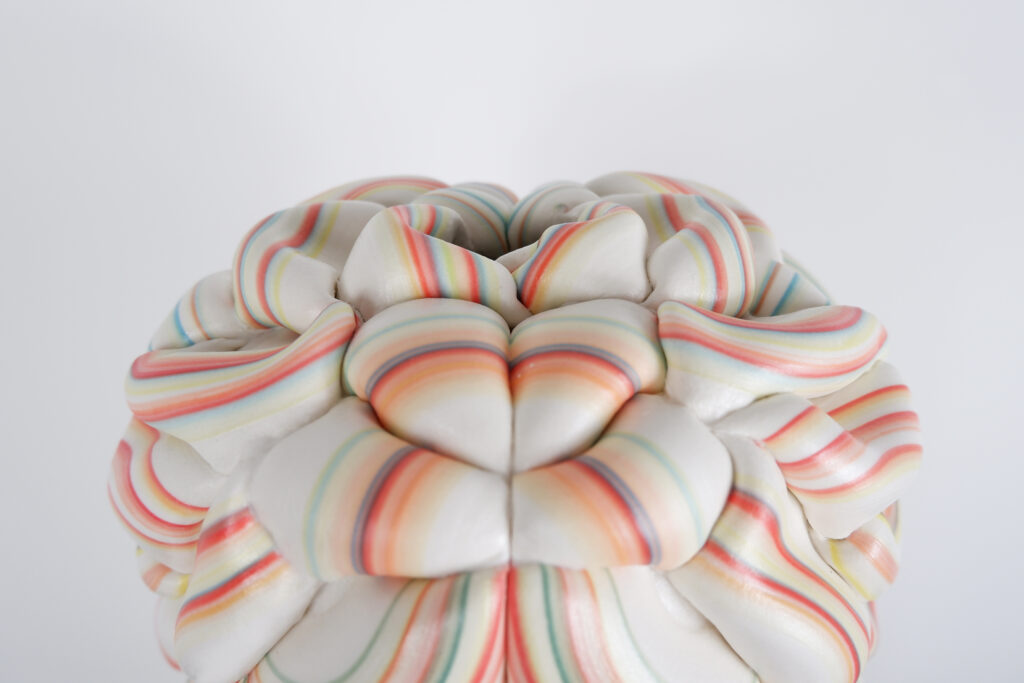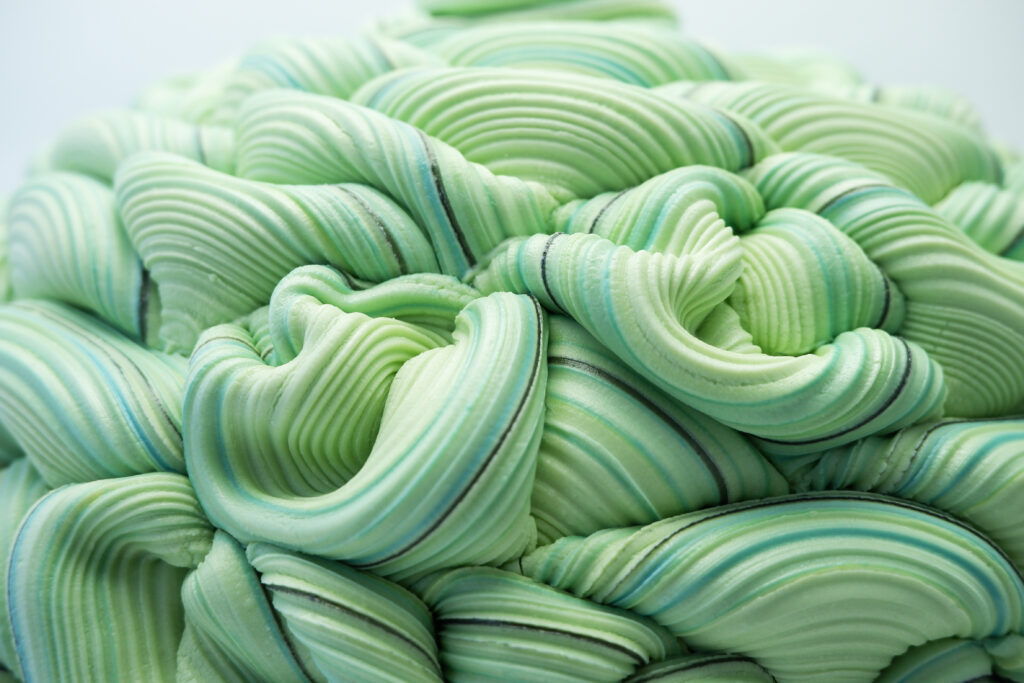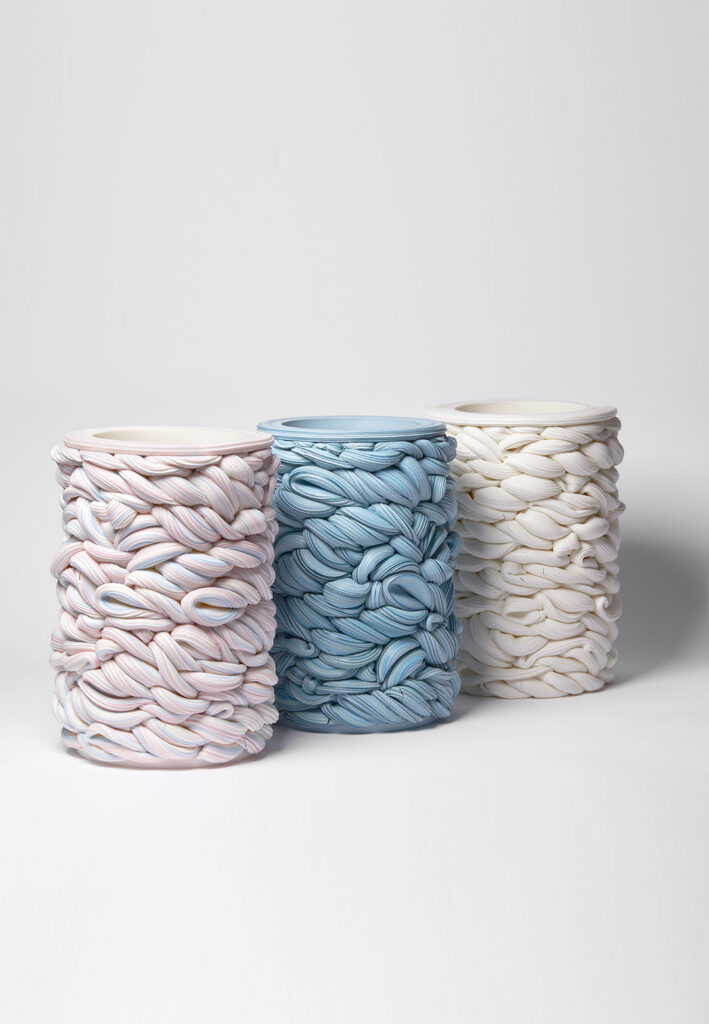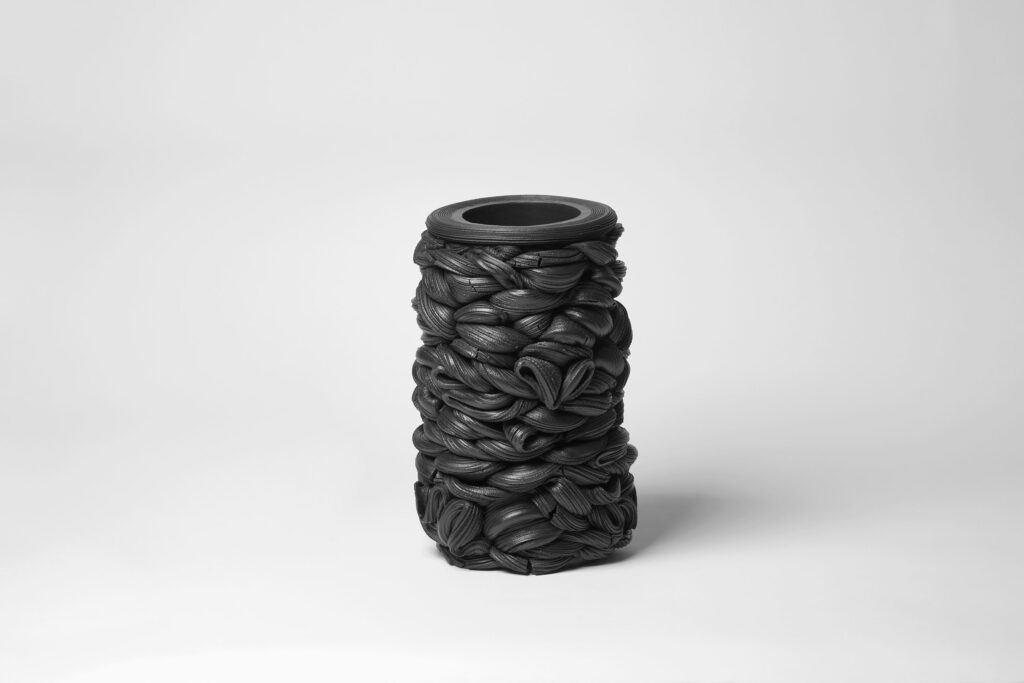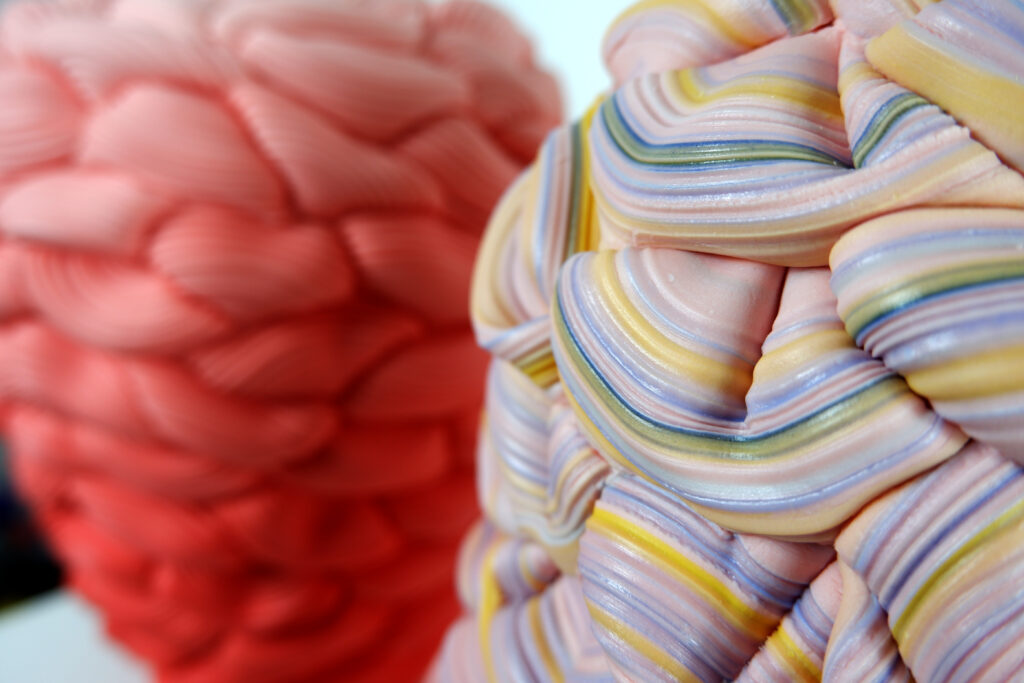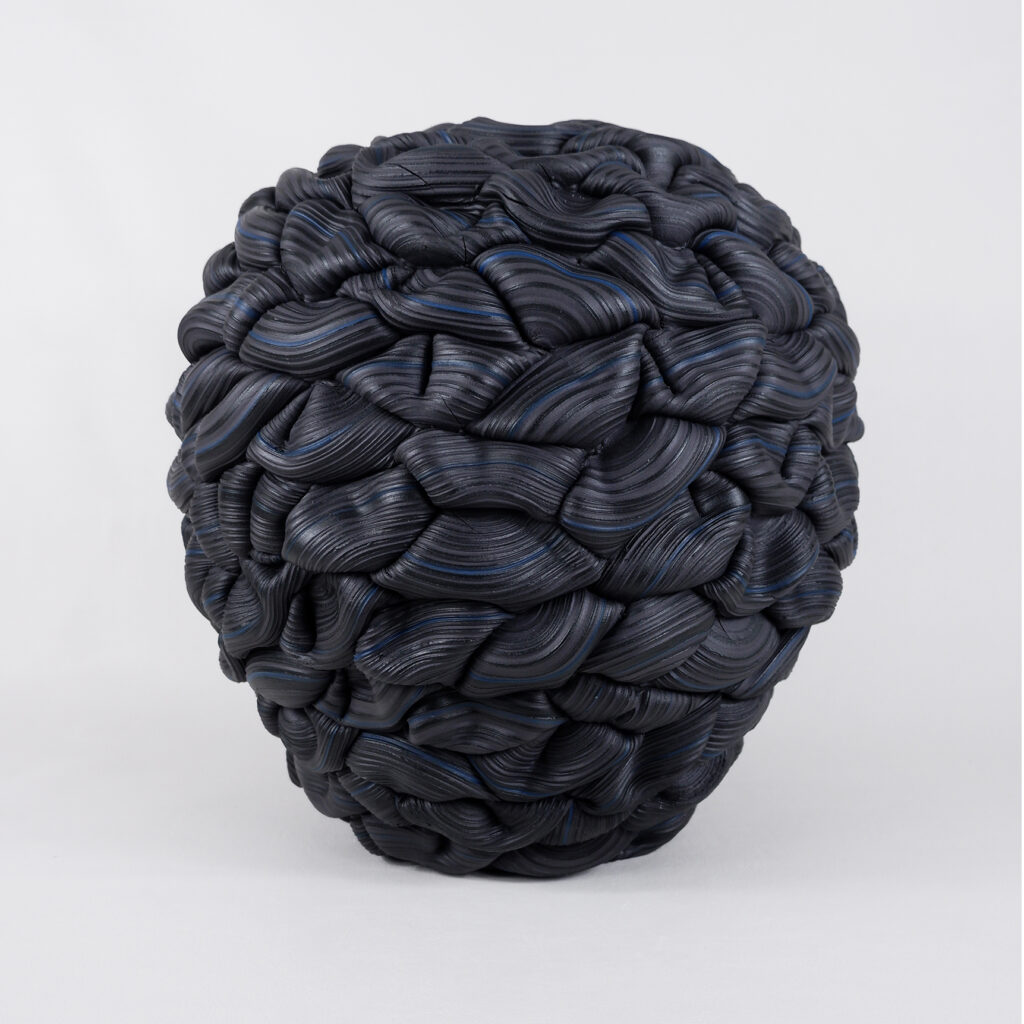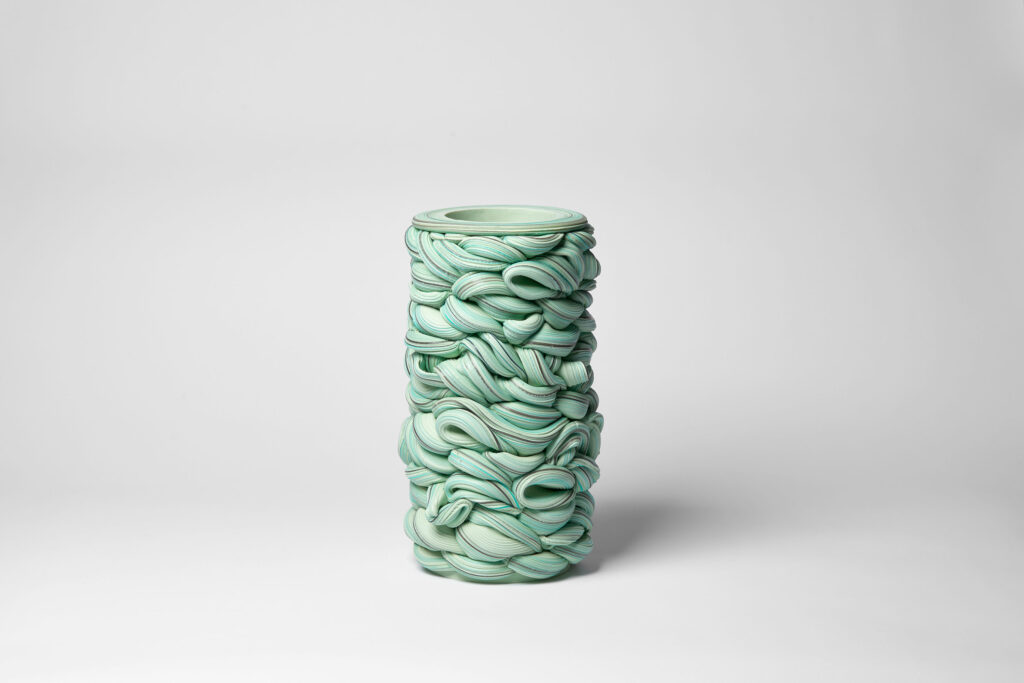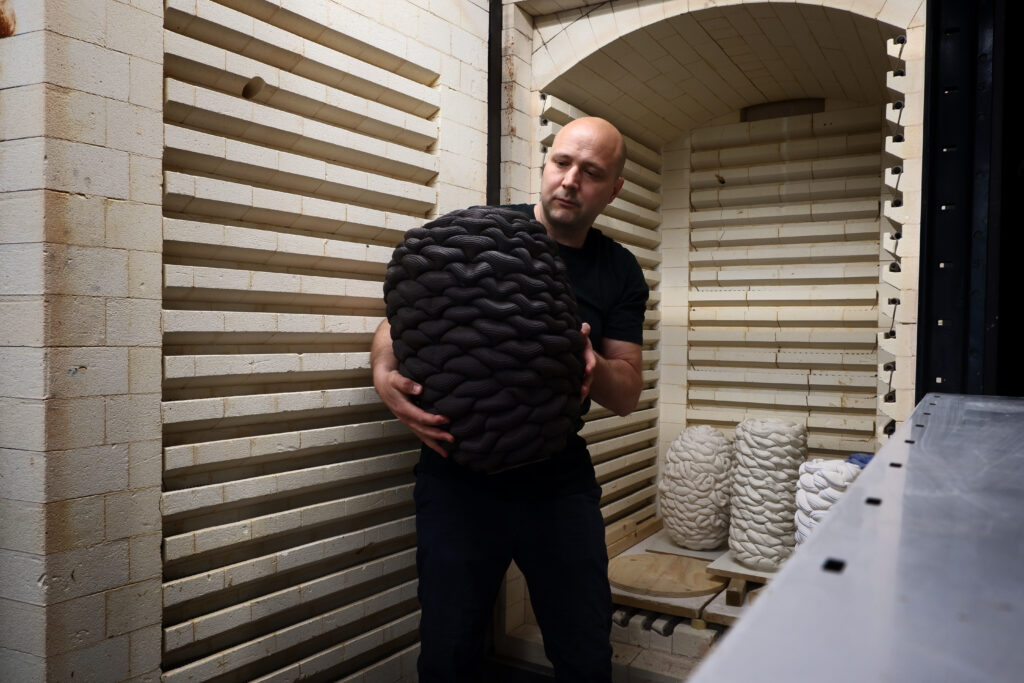
Ceramic artist Steven Edwards was born in the UK in 1976. He currently lives and works in Surrey.
Recently showcased at Collect Art Fair 2024 at Somerset House, London.
interview with ceramic artist steven edwards
Steven Edwards, based in Surrey, UK, is one of the world’s master manipulators of clay. Armed with four separate degrees in Ceramics, Fine Art, and Graphic Design, Edwards has spent the best part of 26 years consolidating his understanding of clay, leveraging his profound knowledge of its chemical makeup to yield unprecedented sculptural forms and compositions in this often volatile medium. Edwards started his career with a desire to challenge the traditional ways of working with clay, such as throwing on a wheel or hand-building, and firing, seeking instead to deconstruct these processes in a way that redefines their relationship to the medium and thus the artwork. Inspired by the ethos of Process Art pioneers such as Joseph Beuys and Richard Serra, Edwards’ ceramic vessels become a record of his process – a record in clay. Working with hand-thrown cylindrical clay forms, Edwards engages in a stringent layering process that deftly balances compression and tension as he manipulates the clay into evoking unique and constrained surface finishes. Born out of the process of making, each vessel is an evocation of an intangible duality: stillness and flux, control and unpredictability, as the artist adopts the role of maestro and the unruly clay his symphony. In this manner, the artist delves into the dynamic interplay between maker and medium, where the final artwork emerges as a manifestation of the inherent tension imbued by the act of creation. ‘Adding obstructions to the surface of the clay is like placing a boulder in a stream; it changes the flow. How do these changes then impact the final form?’ questions Edwards. An added layer, a deeper pressure point, each subtle manipulation guides the clay into explorative states that defy expectations of what constitutes harmony within the vessel. This intricate process is a testament to Edwards’ years of dedicated experimentation and technical mastery. His acute understanding of the clay’s inherent properties and the boundaries within which he can push, gives rise to each finished work – embodying a measured chaos that can only be described as perfectly imperfect. The rhythm of the process is further imbued through colour. Rather than applying glazed slips as an additional layer to the vessel, Edwards integrates his dyes directly into the clay during the initial stages. This method enables the movement of the work to be more profoundly enhanced within the vessel, as the darker shades accentuate deeper contours, emphasising strain and pressure more effectively. Edwards has exhibited extensively across the UK, including at the British ceramics Biennial in 2019 as well as international representation at for example, Paris Design Week, 2021.
How long have you been working with clay?
I have been working with clay for approximately 30 years, initially delving into its expressive potential during my studies in art and design at college. I decided to pursue a career in design after further study, spending 18 years as a Graphic Designer, and creating ceramic work in my spare time, followed later by completing a Masters degree in Ceramics in 2018. At this point I began to focus more of my time on my ceramic portfolio and transition to building a career as a full-time artist.
How would you define clay and your relationship to it?
The different states of clay from wet to dry and finally to ceramic invite curiosity, creativity and expression. Clay in its malleable state invites touch and manipulation. When it’s dry, texture and fragility freeze its characteristics. The final transformation into ceramic reveals unexpected outcomes and tactility. It’s the immediacy of clay that resonates most with me, it allows the process of making and my interaction with it to be recorded.
Which artists, either contemporary and historical, have had an impact on you over time?
My interests have always been drawn to the avant-garde approach to art, craft and design – for its originality, vision, ideas and invention. A recurring influence from my art studies to today, has been the Surrealists, Fluxus and Process Art. Artists like Joseph Bueys, Max Ernst, Duchamp and Richard Serra with their provocative experimental approach to art expressed through performance, language and materials have been a key influence.
A huge influence in ceramics is Akiyama Yo due to his mastering of revealing geological references in the material. The scale, technique and method of making in his work is something I really admire. He was a leading figure of Sōdeisha, an avant-garde ceramicist group that reimagined ceramics as a nonfunctional sculptural practice.
What other influences have seeped into your work during your career?
Graphic Design continues to influence my work. Information graphics, use of language along with form, typography, grids and colour have all been integrated into my ceramic sculpture ideas and development. This has informed my approach to process-led making where the forms I create portray a visual dialogue through animated malleable woven shapes and bold graphic use of colour.
Are there any traditional threads that exist in your practice? If so, what are they?
I mainly use the pottery wheel to create my pieces. Building ideas and processes from skills gained in all aspects of the traditional techniques; from repetitive production throwing to large scale thrown and altered forms, I purposely adapt the processes to provoke alternative outcomes.
Can you explain your process of making?
The initial stages of making are focused on clay preparation, where I combine different clays both wet and dry with additions of colour and strengthening materials. I spend most of my time at the wheel throwing repetitive forms, applying surface texture with profiles and colour using slips. Each layer of the folded form is a thrown clay sphere containing trapped air which is released when cut and compressed together on a base form. This buildup of layers introduces stress and tension areas in the surface, along with trapped air blown out and cracks where the clay particles have become unstable and move in the drying and firing process. From the stages of making to the final firing, I am guiding the clay into a form that expresses contained energy, movement and mark-making to ultimately expose a record of the making process.
What role does experimentation play in your artistic practice?
Experimentation is an important aspect of my process-led approach to making. My creative practice purposely places clay under stress to reveal the natural tension and movement in its surface and form. Throughout the making process I push, pull, compress and slice the material to provoke a reaction. The final forms are a combination of these making scenarios, translating a theme of duality in their appearance – the contrast of visual distortion and precision, the stillness and movement in form and the surface deception between synthetic and natural. Where cracks and weaknesses can be considered a flaw in the material and final pieces, I am looking to build on this aesthetic – a mixture of control and uncontrolled results after the clay has been put through a process.
What role does colour play in your work?
In the early developments of my work, I used gradations of colour to emphasise the tension in the compressed surfaces. This evolved to linear/banded applications to blend movement and draw the viewer in to explore the surface weave. This has informed the different series of works; monochromatic, achromatic, analogous, striped and banded. I have purposely introduced the broad use of colour to my work, influenced by my background in Design. I use colour as a toolkit to add variation, creating controllable palettes to enhance the overall aesthetic impact of a piece.
Would you say your work is charged with emotion – If so, which emotions and do you think the viewer might be able to feel them?
My works stir curiosity within the viewer, inviting exploration into the making behind each piece and the tangible allure of its surface. For example, my recent series of symmetrical work encourages the viewer to investigate around the vessels where symmetry is inherent in halving and mirroring identical surfaces. The combination of harmony and order is disturbed by the handmade irregularities of the surface application.
In my parian porcelain pieces, the clay texture and surface have a synthetic appearance after they are fired, questioning whether the material is ceramic. I have exploited this characteristic by layering and blending lines of colour to create a glazed sweet appearance, similar to boiled sugar confectionery.
What are some of the core themes/concepts that you explore in your ceramic work, and why are they important to you?
I make ceramic vessel sculptures. They are inspired by an ongoing interest in process and form, where specific steps are applied to making to explore the materiality and physicality of clay. The work is guided by the material through a process that pushes the limits of the clay to provoke a reaction and reveal aesthetic qualities that give the sculptures character and form.
The application of a set process comes from observing the language used in the act of making. This has enabled me to build a vocabulary of techniques that expose the seductive attributes of the clay. For example, my current work explores repetition, cut and compression. Repetition is the rhythmic production throwing of spheres, cut is the act of altering form and compression is the manipulation of the forms that build up a layered vessel. This approach to making is also used as a method to create drawings, prints and writing, to decipher inspiration and thoughts.
Fundamentally the work is focused on the vessel, the internal and external space that is subject to many interpretations throughout history – a container, a social object and conjurer of intrigue.
What is your perception of the recent surge in interest in ceramic art?
I think the combination of tradition and innovation in ceramic art seems to captivate audiences, allowing artists today to push the material out of its comfort zone and blur the lines between fine art and craft. I work in a university where there has been resurgent interest from students in ceramics across a range of disciplines, this reflects a broader cultural shift towards appreciating artisanal craftsmanship and the tangible, tactile qualities of handmade objects. Ceramic art offers a unique blend of creativity that resonates with contemporary audiences and is drawing in fresh generations of collectors seeking release from their digital lives. Additionally, the rise of social media and online platforms has made it easier for ceramic artists to showcase their work and reach a wider audience.
“Adding obstructions to the surface of the clay is like placing a boulder in a stream; it changes the flow. How do these changes then impact the final form?”
.
[Steven Edwards in conversation with Art Formes]

